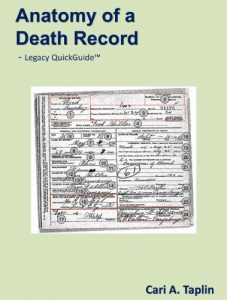Death records are one third of the set of records known as “vital records” which also include birth and marriage records. These three types of records are commonly referred to as “BMD” and provide valuable information for good genealogical research. Death records generally were kept starting in the early 1900s, depending on the state. While they are a relatively recent document, death records can still give information for individuals back into the early 1800s due to the span of data contain. Since death records are created at the end of an individual’s life, information other than the death itself should be carefully examined for errors. Often those providing information were not as familiar with the deceased’s birth and parental information. The information below is designed to assist the researcher in understanding data found in death records when they are available, the differences between death certificates and registers, and research methods, tips and resources to use when they can’t be located or don’t exist.
The Anatomy of a Death Record Legacy QuickGuide™ contains valuable information on how to interpret the data in a variety of death records including death certificates and death registers.
The Anatomy of a Death Record Legacy QuickGuide™ contains valuable information on how to interpret the data in a variety of death records including death certificates and death registers.






